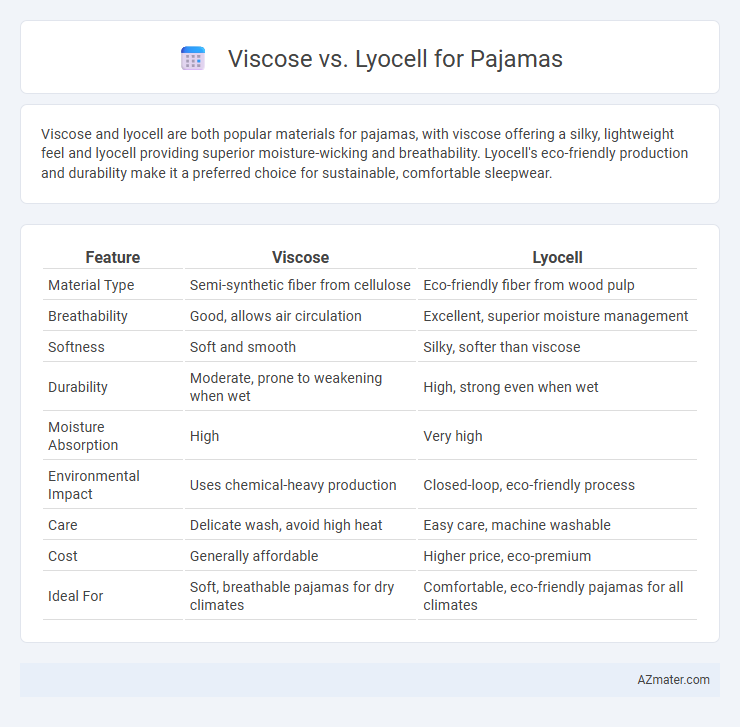Viscose and lyocell are both popular materials for pajamas, with viscose offering a silky, lightweight feel and lyocell providing superior moisture-wicking and breathability. Lyocell's eco-friendly production and durability make it a preferred choice for sustainable, comfortable sleepwear.
Table of Comparison
| Feature | Viscose | Lyocell |
|---|---|---|
| Material Type | Semi-synthetic fiber from cellulose | Eco-friendly fiber from wood pulp |
| Breathability | Good, allows air circulation | Excellent, superior moisture management |
| Softness | Soft and smooth | Silky, softer than viscose |
| Durability | Moderate, prone to weakening when wet | High, strong even when wet |
| Moisture Absorption | High | Very high |
| Environmental Impact | Uses chemical-heavy production | Closed-loop, eco-friendly process |
| Care | Delicate wash, avoid high heat | Easy care, machine washable |
| Cost | Generally affordable | Higher price, eco-premium |
| Ideal For | Soft, breathable pajamas for dry climates | Comfortable, eco-friendly pajamas for all climates |
Understanding Viscose and Lyocell: Key Differences
Viscose and lyocell are both semi-synthetic fibers derived from cellulose, but lyocell is produced through a more environmentally friendly closed-loop process that recycles chemicals and water. Viscose tends to be softer and more breathable, making it ideal for comfortable pajamas, while lyocell offers superior moisture-wicking and durability, enhancing long-term wear. Understanding their different fabric constructions and sustainability profiles helps consumers choose pajamas that balance comfort, eco-friendliness, and performance.
Production Process: Viscose vs Lyocell
Viscose is produced through a chemical-intensive process that involves converting wood pulp into cellulose xanthate, followed by regeneration into fibers using toxic solvents like carbon disulfide, which raises environmental and health concerns. Lyocell is manufactured using an eco-friendlier closed-loop process where wood pulp is dissolved in non-toxic N-methylmorpholine N-oxide solvent, allowing over 99% solvent recovery and reduced chemical emissions. The sustainable production of Lyocell results in lower environmental impact, making it a preferred choice for eco-conscious pajama fabrics compared to conventionally produced viscose.
Softness and Comfort: Which Feels Better?
Viscose and lyocell both offer exceptional softness for pajamas, with lyocell generally providing a smoother, silkier feel due to its fine fiber structure. Lyocell excels in moisture-wicking and breathability, enhancing comfort by keeping the skin cool and dry throughout the night. Viscose remains a popular choice for its plush texture and affordability, though it may lack the superior durability and eco-friendly production process found in lyocell.
Breathability and Moisture-Wicking Properties
Viscose and lyocell are both breathable fabrics, but lyocell offers superior moisture-wicking properties due to its unique fiber structure that efficiently pulls moisture away from the skin. Viscose provides good airflow and comfort but tends to absorb moisture without dispersing it quickly, which can lead to a clammy feeling. Choosing lyocell for pajamas enhances breathability while maintaining dryness, making it ideal for sensitive or warm sleepers.
Durability and Longevity of Pajamas
Viscose pajamas tend to be less durable due to their tendency to weaken when wet and frequent washing, which can lead to quicker fabric degradation. Lyocell pajamas offer superior longevity, as the fabric maintains strength even after multiple washes and resists pilling, making them a long-lasting choice. The sustainable production process of lyocell also enhances its fiber integrity, contributing to extended pajama wear over time.
Environmental Impact and Sustainability
Viscose production involves chemically intensive processes and often relies on non-sustainable wood sources, leading to deforestation and water pollution concerns. Lyocell is manufactured using an eco-friendly closed-loop process that recycles solvents and utilizes sustainably harvested wood pulp, significantly reducing environmental impact. Choosing lyocell pajamas supports sustainable textile practices and lowers ecological footprints compared to traditional viscose options.
Skin Sensitivity: Hypoallergenic Considerations
Viscose and lyocell differ significantly in hypoallergenic properties, with lyocell being more suitable for sensitive skin due to its natural, chemical-free production process and high moisture-wicking ability that reduces irritation. Viscose, often treated with chemicals during manufacturing, may cause allergic reactions or discomfort for individuals with skin sensitivities. Choosing lyocell pajamas supports skin health by minimizing exposure to synthetic residues and promoting breathability, making them a preferred option for hypoallergenic sleepwear.
Care and Maintenance: Washing and Drying Tips
Viscose pajamas require gentle hand washing or machine washing on a delicate cycle with cold water to prevent fabric weakening and shrinking, and should be air-dried flat or hung away from direct sunlight to maintain softness and shape. Lyocell pajamas withstand machine washing on a gentle cycle with cold or warm water and benefit from tumble drying on low heat or line drying to avoid fiber damage and maintain breathability. Both fabrics need careful handling to preserve their smooth texture and durability, with lyocell generally being more durable and resistant to shrinking than viscose.
Price Comparison: Cost of Viscose vs Lyocell Pajamas
Viscose pajamas generally cost less than lyocell pajamas due to cheaper production processes and raw materials. Lyocell, derived from sustainably sourced wood pulp and produced through a closed-loop system, commands a higher price reflecting its eco-friendly manufacturing and superior durability. Consumers seeking budget-friendly options often choose viscose, while those prioritizing sustainability and longevity invest in pricier lyocell sleepwear.
Final Verdict: Which Fabric Is Best for Pajamas?
Viscose offers a soft, breathable feel ideal for lightweight pajamas, but its moisture-wicking properties and durability can lag behind lyocell. Lyocell pajamas excel in eco-friendliness, superior moisture absorption, and silky smooth texture, making them better suited for temperature regulation and long-term wear. For optimal comfort, sustainability, and performance, lyocell is the best fabric choice for pajamas.

Infographic: Viscose vs Lyocell for Pajama
 azmater.com
azmater.com